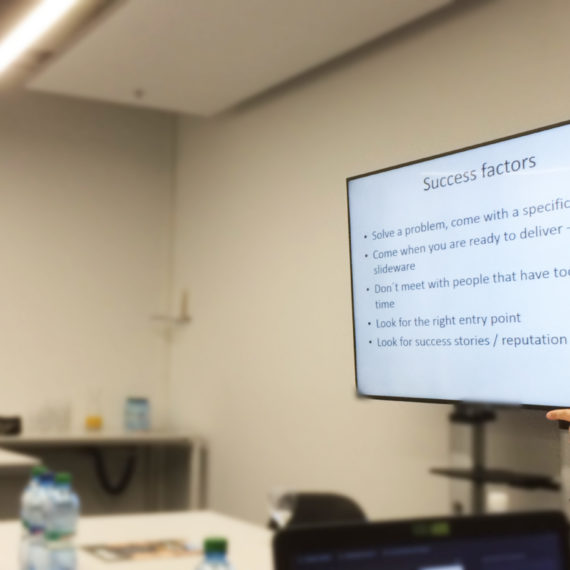These days, many large corporates work with start-ups. From the start-ups’ point of view, these opportunities raise numerous questions: What do I gain from working with a corporate? When is the right time to make contact? And how can I find the right person to help me? At the Founders Circle Workshop, organised by venturelab, Penny Schiffer, Swisscom’s Head of Startup Initiatives, suggested some answers.
Twelve start-up founders arrived early in the morning at the StartUp Space in Schlieren. They came from a variety of sectors: cloud, security, e-commerce, IoT and health. However, they all wanted to ask the same question: “How to land a big corporate as my first client?” Here, we summarise the main conclusions of the workshop.
Why hunt for the big fish?
3 big advantages
Sales revenues
With a big corporate, you can get bigger sales revenues – more users mean more licence fees. With one deal your company can make a huge jump all in one go.
Quality stamp
A big name on your customer list can also help to attract other customers and even get special attention from investors: “If start-up X has managed to convince such a big corporate, there must be something going for it.” Working with a big name works as a quality stamp on your business case and your team.
Business support
Another aspect of having a corporate as a partner may be the business support they can offer in terms of access to customers, infrastructure support, or expert advice. If played well, your start-up can tap into a market that otherwise you would not have been able to access.
Some things to be aware of
Sales cycles
Selling to a big company often means sales cycles that are not only much longer but also very complex. Initially, you may not talk to the person who actually has the budget. However, this person may be able to refer you to the project team. Then they run a test, and another test, and write a proposal. It may take longer than you think.
A lot of attention on one entity
Winning a big customer often means focusing a lot of attention on one entity. This can pose a cluster risk to your company: if this one contract goes south, you go south. When focusing on one big potential customer, make sure that you don’t neglect some of the other opportunities out there.
Specific requirements of a corporate
The requirements of a corporate could be very specific, e.g. they need the solution to run in their environment or are willing to pay for an extra feature that no-one else can use. Some of these extra efforts have the potential to lead to new products, while other efforts cannot be re-used and therefore may distract the start-up. So keep sight of your core value proposition all the time.
When is the best time to reach out?
Corporate structures
Sometimes it takes longer than expected to move from initial interest to the project stage because a corporate like Swisscom has decision-making processes, budgets and legacy that all take time. What seems long for a start-up (e.g. 12 months) feels like the blink of an eye from the corporate perspective.
Maturity of start-ups
On the other hand, the maturity of start-ups is a crucial factor. When a start-up is still in its very early stages, the likelihood of winning a corporate is low. Why? The team will not be able to deliver to the scale or quality that a corporate would need. Two guys with a prototype will need around 18 months before their software can secure the network of a big organisation.
There seems to be a chicken-and-egg situation with regard to timing. On the one hand, it would be great to start collaborating as early as possible. However, the likelihood of the project succeeding is much higher when the start-up has everything in place to deliver the solution.
Dos and dont’s when reaching out to a corporate
Solve a problem
Try to solve a problem for the corporate, so come with a specific pitch instead of a generic investor presentation. Penny Schiffer received a pitch from an IoT company some time ago that outlined how it would leverage Swisscom’s Lora Network and drive additional revenues for Swisscom. This was a good example of a pitch because it caught attention as it was relevant for Swisscom’s M2M unit.
Ready to deliver
Come when you are ready to deliver – come with a product or even revenues, not just slideware. A working prototype of a gadget doesn´t mean that you have the production, logistics and service organisation in place that you will need to produce and sell thousands of pieces.
Finding the right person
Finding the right person to talk to will be crucial. It can sometimes be difficult to find this person because the structure of the organisation is not fully transparent to the outside world. Use the corporate website and social media to do your research beforehand and reach out to someone.
Success cases within Swisscom
We have some examples of successful collaboration with start-ups, e.g. with Katia for the call spam filter, with MycoSolutions for the protection of our telephone poles or with Livingdocs to help us manage our content on Bluewin more efficiently.

